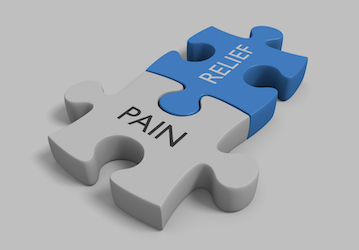Effectively managing pain can be complicated. Some forms of pain can have emotional, mental, spiritual, and relationship consequences, but each of these elements also can help you manage your pain. The common process for dealing with pain is often too passive: You realize you are in pain. You tell your healthcare provider. He or she prescribes a medication and perhaps some things for you to do or not do. You, as the person in pain, simply follow the instructions.
When you take an active role working with your healthcare provider to manage your pain, you can help protect against unwanted side effects such as dependence or potential misuse of prescribed pain medications. For example, opioid pain relievers such as oxycodone, codeine, and morphine are common medications prescribed to help individuals with moderate to severe pain, but addiction and overdose have become a national epidemic.
The more involved you are in the process of managing your pain, the more likely you are to effectively use the treatments prescribed appropriately, and the more in control you will feel as you progress through your treatments. Feeling in control can be important for you to maintain hope and stay mentally strong as you manage your pain.
One way you can take a more active role in your pain management is to learn about less common methods to ease your pain and, together with your healthcare provider, explore options to find a plan that will work for you. You also can use these strategies with loved ones to build your relationships, as well as maintain your spiritual, mental, and emotional health.
Alternative pain-management strategies
The Defense & Veterans Center for Integrative Pain Management (DVCIPM) and the Army Pain Management Task Force recommend a number of pain-management strategies that you can use alone or with other treatments to help you manage your pain. Discuss with your doctor which of these might be helpful for your situation.
- Yoga is gaining attention in the military as a strategy to enhance fitness and address physical pain. It often blends exercise and stretching with deliberate breathing and meditation. Yoga can sometimes help improve back pain, arthritis, fibromyalgia, and general pain. It also might help improve your mood and alleviate stress.
- Acupuncture is an ancient practice that can sometimes improve migraines, nausea, back pain, chronic pain, and more. Acupuncture involves the use of thin needles to prick the skin or tissue at specific points on the body.
- Battlefield acupuncture is a form of acupuncture using needles in just the ear, rather than in various parts of the body as with traditional acupuncture, that is easier to transport and administer in the field.
- Biofeedback involves sensors on your body to provide you with real-time medical data. This enables you to practice strategies such as muscle relaxation, deliberate breathing, or mental imagery to experience the immediate results on your body’s functions. Biofeedback can help you more effectively practice such strategies to reduce, for example, migraines and neck, shoulder, and back pain.
- Therapeutic medical massage is when a trained masseuse applies pressure to muscles or soft tissue to address a direct medical goal, such as relieving pain, compared to general relaxation. Massage can improve blood flow, calm the nervous system, and relax muscle tension to help relieve pain.
- Mind-body therapies also can help you relieve pain by helping shift your attention, calm your body, and relieve stress. HPRC’s “Mind-body strategies for pain” provides information on relaxation techniques, meditation, imagery, and redirection. Another mind-body strategy that can help address pain is Tai Chi, a traditional Chinese practice that involves controlled movements and breathing.
Take control of your pain!
Dealing with pain is not fun, but there are steps that you can put into action to take a more active role in the management of your pain. Once you’ve learned about the different strategies available, you can discuss them with your healthcare provider. It’s always important to prepare in advance for an appointment so you can ask direct questions to help your healthcare provider find the best pain management plan for you. Another tool you can use to give your provider useful information is to complete the pain rating scale from the Veterans Health Administration. And explore the other articles and resources in HPRC’s Pain Management section for even more information.
